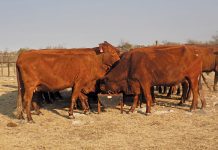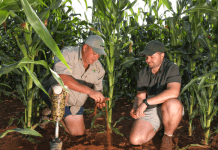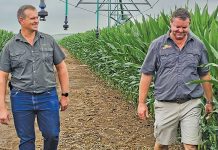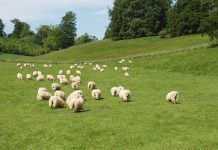The Agricultural Research Council’s Institute for Soil, Climate and Water (ARC-ISCW) has been running a project over four seasons to demonstrate commercial conservation agriculture (CA) practices on 4,7ha in the Qunu area of the Eastern Cape. The main aim has been to show farmers that its implementation can curb land degradation and results in higher soil productivity and yield and improved profit. Peter Hittersay
Land degradation and soil erosion are prevalent in poor communal areas of the Eastern Cape. This is due to incorrect cultivation practices, cultivation of marginal land and overgrazing. Arable land is also becoming scarce. There’s an urgent need to implement land and soil rehabilitation technologies like conservation agriculture (CA) to curb the decline in organic matter, soil fertility and below-the-surface biodiversity.
CA will also improve rangeland
biomass production and soil cover to retard soil erosion and retain soil water.
Recognising this, the Agricultural Research Council’s Institute for Soil, Climate and Water (ARC-ISCW) launched a project to demonstrate commercial conservation agriculture (CA) on a trial site of 4,7ha in the Qunu area, about 40km from Mthatha (Umtata). Spanning four seasons, the intention was to prove that the implementation of CA practices can curb land degradation, increase soil productivity and yield and therefore improve livelihoods. The soil on the trial land can be classified as a Hutton form of the Hayfield family. It has a sandy loam texture and a clay content of 16%. Prior to the project, maize was planted by using the traditional mouldboard plough. Original soil pH (H2O) was 6,1 with low values for phosphorus (Bray 1) and potassium of 5 and 60mg/kg, respectively. Cation exchange capacity was low at 5,3 cmol (+)/kg soil.
Mean annual rainfall in the area is 624mm of which 420mm falls in the active growing season for maize.
Four blocks of land were planted – one was planted to traditional conventional maize, two blocks of maize and soya beans were grown in annual rotation and one block had maize intercropped with lablab and cowpea. The trials were aimed at implementing CA practices based on the principles of minimal soil disturbance (ideally no-till and direct seeding), permanent soil cover (ideally 100% use of crop residue and/or green manure cover crops) and multicropping (ideally crop rotation).
Trial block preparation and husbandry
To achieve minimum or reduced tillage, a combined two-shank ripper-planter was used. Ripping was done to a depth of 400mm, while planting was done in the ripped lines by the planters mounted on the ripper framework. In terms of the maize/soya bean rotation and intercropping, the maize cultivar PAN 6479 was planted to achieve 30 000 plants per hectare. Plant density aimed for in soya bean (LS 6164R), lablab (Rongai) and cowpea (mixed brown) was 200 000/ha, 55 000/ha and 70 000/ha respectively. Pre-plant and pre-emergence weed control was done by following commercial agronomic practices using Roundup and Basagran, as well as Cypermethrin for pest control. Fertiliser application was variable in accordance with soil analysis and targeted yield, but was usually about 250kg of 2:3:2 (22% concentration) for maize and 150kg/ha super phosphate and 50kg/ha potassium chloride (KCl) for legumes. Top dressing of nitrogen at about 170kg/ha is applied, while limestone ammonium nitrate (LAN) for maize was applied six weeks after planting.
As a control, the traditional block of land dedicated to conventional tillage practices was mouldboard ploughed to a depth of 200mm with a 50kW tractor and then harrowed with a team of oxen. Planting of cultivar PAN 6479 maize to achieve 30 000 plants per hectare was done using a single row planter behind a 50kW tractor during which 2:3:2 fertiliser was applied at a rate of 150kg/ha. Ideally, land preparation and planting are done with a team of oxen. No top dressing or pest or weed control measures were applied. Nitrogen was also not applied as a top dressing due to this not being a traditional practice. The maize in this block had a yellowish tinge, clearly indicating a deficiency.
Impressive results
The ARC-ISCW recently held an information day in Qunu, reporting back on the project and the objectives achieved. The results of the trials for the 2008/09 growing season were impressive. During the first two months after planting, only 90mm of rain fell, followed by a downpour of 90mm on 14 and 15 February. Soil water content was dramatically reduced by about 50%, but was especially detrimental to maize growth in the traditional block, compared to the CA blocks. The trials didn’t only intend to show that CA farming can improve soil and land productivity, but also that it’s economically viable. Figure 1 shows yield and gross margins for the last two seasons (2006/07 and 2007/08) for the various cropping practices. Compared to the traditional land where maize was produced at a huge loss of between R2 450/ha and R1 810/ha, the CA crops showed gross profit margins between R990/ha and R4 270/ha. These results prove that despite higher inputs on the CA land compared to the traditional land, CA can be promoted as economically viable.
Soil compaction (soil strength > 1 200kPa) in the traditionally mouldboard ploughed block was at about 220mm deep whereas that of the CA blocks only started at about 420mm. Soil water content 100 days after planting was highest in the rotation maize, followed by intercropped maize, with traditional maize having the lowest.
One of the most important benefits of conservation agriculture is that this practice promotes the sequestration of carbon and nitrogen in the soil, thereby reducing the emission of CO2 and nitrous oxides into the atmosphere. In this way, cropland agriculture can mitigate the effects of global warming. Farmers who adopt CA practices can also enter the carbon trading market. Graphs 1 and 2 clearly show that the CA land sequestrated more carbon (1 050kg/ha) and nitrogen (110kg/ha) than the traditional maize block.
Besides being a high-protein foodstuff, soya bean is an excellent crop to rotate with maize and wheat and can result in a 12% to 15% yield increase in the follow-up crop due to the fixation of about 210kg LAN per hectare, an increase equal to about 60kg/ha in soil nitrogen. Graph 3 identifies the increase in on-the-row inorganic soil nitrogen for soya bean and lablab compared to between-the-row and the maize stands, which received fertiliser nitrogen on the row during planting. Bear in mind that these legumes received no fertiliser nitrogen, so the increase in soil inorganic nitrogen can only be attributed to nitrogen fixation. Also, fixed nitrogen is not available to weeds and will not acidify the soil.
Cowpea is a drought-hardy upright tropical legume of which the leaves, pods and grain can be used as a high protein, vitamin- and mineral-rich foodstuff for human consumption or livestock fodder. This was grown in a maize/cowpea intercrop row rotation and as a companion crop with lablab. They both provide benefits by building up organic matter, increasing soil nitrogen, improving biological activity, protecting the soil surface and controlling weeds.
Conclusions are that traditional land practices appear to be unsustainable, while the measured benefits of comparative CA practices are the sequestration of soil carbon and nitrogen, increased soil inorganic nitrogen, higher soil water regimes, absence of soil compaction, improved plant nutrient status and higher yield and gross margins.
Contact Dr Danie Beukes, programme manager of the ARC-ISCW on (012) 310 2500 or 082 442 0484 or e-mail at [email protected]. |fw









